The 2025 Milky Way photographer of the year
Photographing the Milky Way is a journey through time, space, and imagination.
While we can only see a small part of the Milky Way with our own eyes, photography allows us to uncover its hidden beauty—showing details, colors, and patterns in the night sky that usually go unnoticed. But beyond the camera and technique, it’s the photographer’s creativity, patience, and sense of wonder that truly bring these images to life.
Now in its 8th edition, our Milky Way Photographer of the Year brings together 25 of the most stunning night sky images captured around the world—and beyond. This year’s collection features a unique Milky Way image taken from space aboard the International Space Station, alongside captivating views from rarely photographed locations such as Chad, Northern Argentina, Socotra Island, Namibia, Australia, New Zealand, and more.
You’ll also see the Milky Way paired with celestial events like a comet, a meteor shower, and a lunar eclipse, showing just how dynamic and magical our night sky can be.
Get ready for an interstellar journey through deserts, mountains, islands, and skies unlike any you’ve seen before—always with the Milky Way as your guide.
“One in a Billion” – Don Pettit
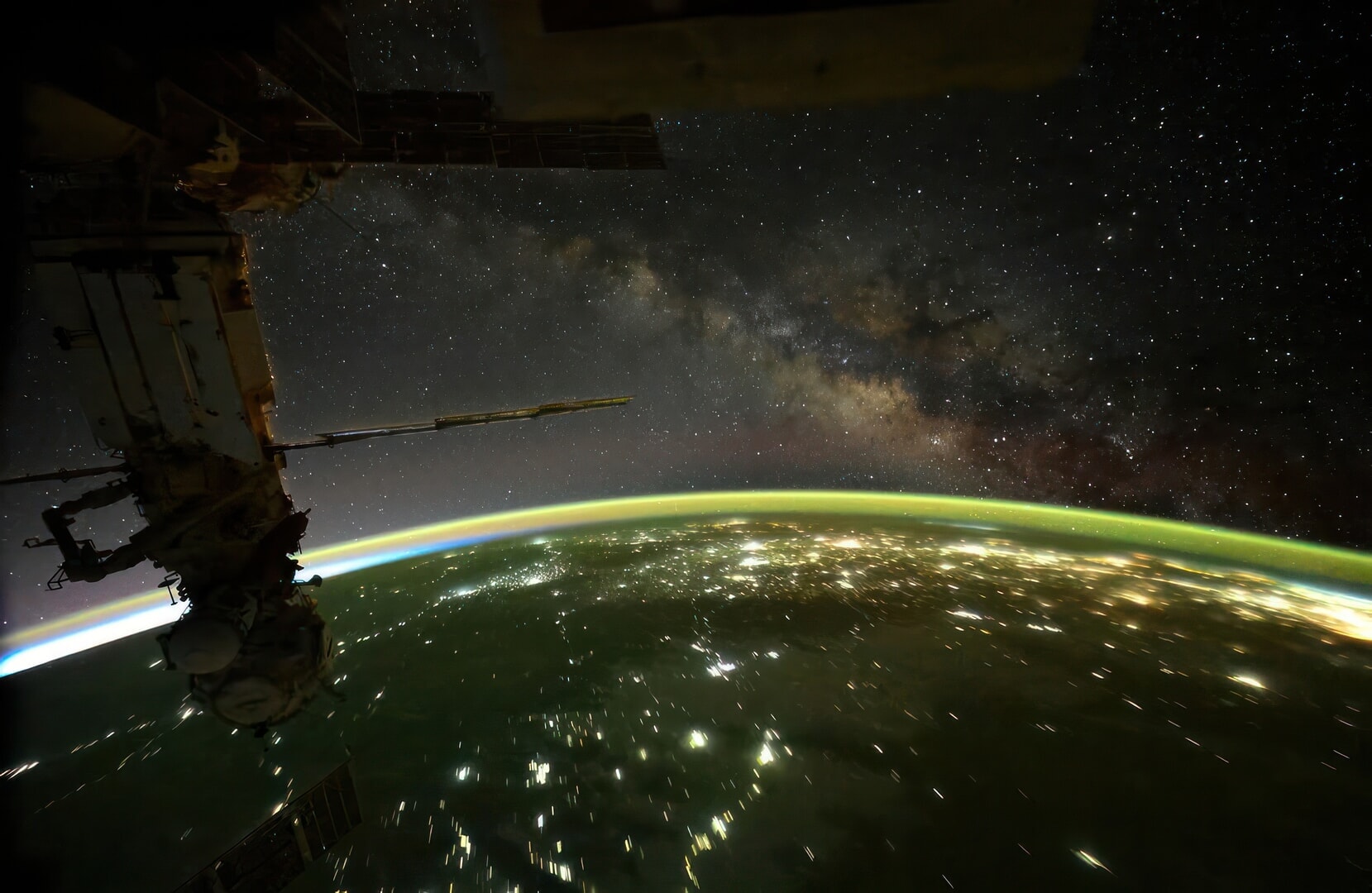
“One in a Billion ” – Don Pettit
- ISS (International Space Station)
I float in the Cupola, looking out the seven windows composing this faceted transparent jewel. While my mind is submerged in contemplation, my eyes gorge on the dim reflections from a nighttime Earth. There are over eight billion people that call this planet home. There are seven of us that can say the same for Space Station. What a privilege it is to be here. I used an orbital star tracker to take out the star streak motion from orbit.
“Tololo Lunar Eclipse Sky” – Petr Horálek
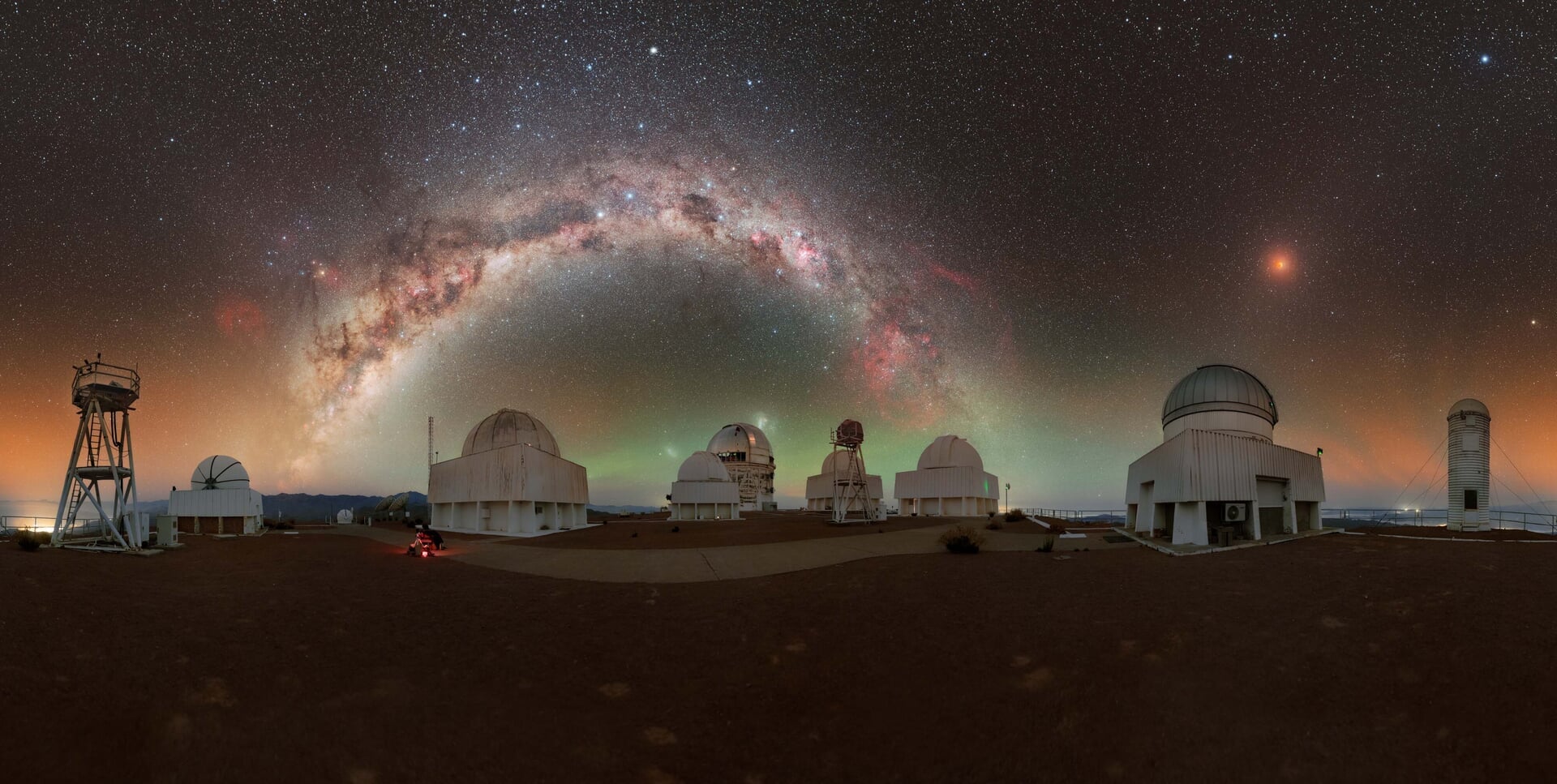
“Tololo Lunar Eclipse Sky” – Petr Horálek
- Cerro Tololo Observatory, Chile
On March 14, 2025, a total lunar eclipse occurred, especially visible over the Americas and the Pacific Ocean. I was fortunate to observe this particular eclipse from the NSF Cerro Tololo Inter-American Observatory in Chile. You can see how epic the sky was during totality, as the Moon darkened enough for the majestic Milky Way, the faint belt of Zodiacal Light, and prominent airglow to stand out.
Canon Ra, Sigma 35mm f1.8, ISO 8000, 81x10s (single exposures stitched to panorama), tripod. Moon is result of HDR work.
- Canon Ra
- Sigma Art 35mm f1.8
“Boot Arch Perseids” – Mike Abramyan
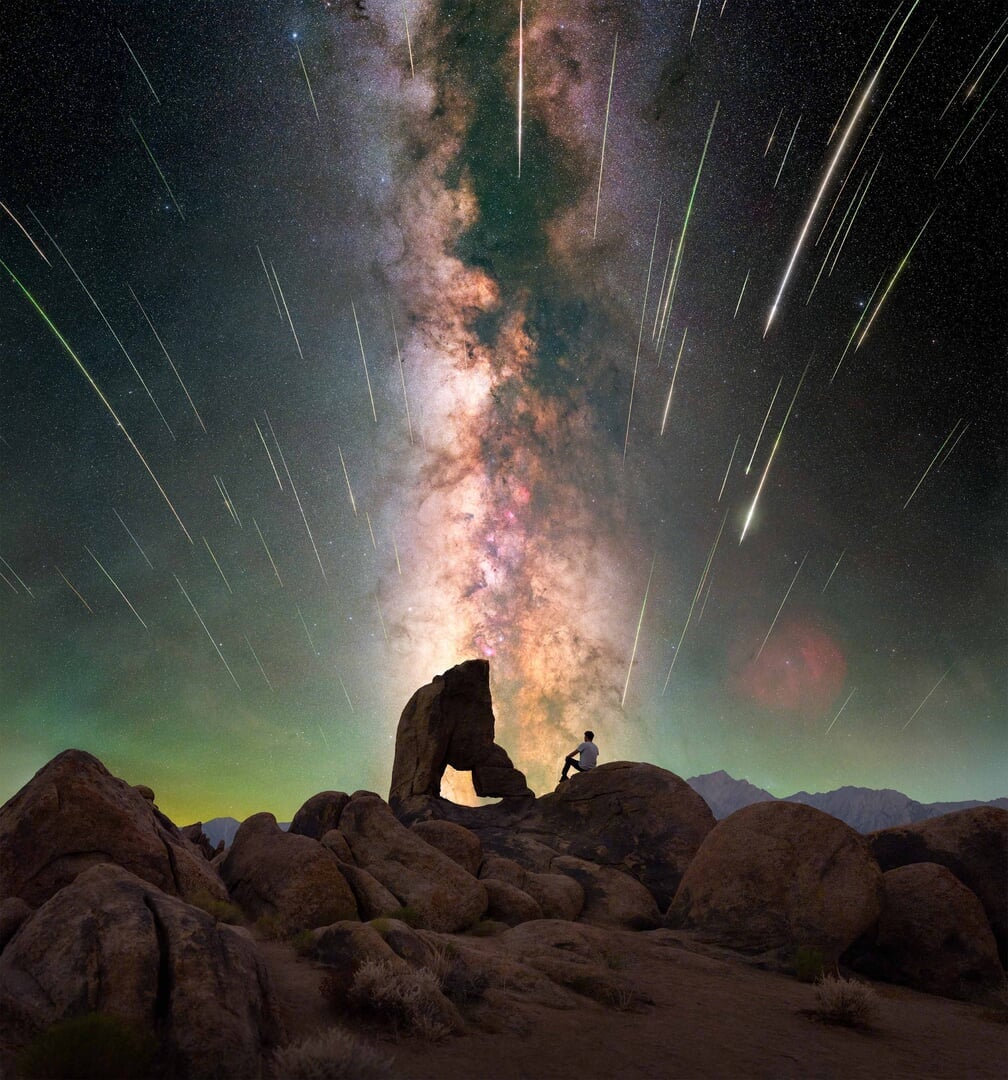
“Boot Arch Perseids” – Mike Abramyan
- Alabama Hills, CA, USA
The Perseid Meteor Shower occurs every August, raining down hundreds of meteors over a few nights. In 2024, I had planned to photograph it from the Canadian Rockies, but wildfires forced me to change my plans at the last minute. After checking wildfire maps, I found a safe haven in the Eastern Sierra Nevada.
After three full nights of capturing meteors, I created this image. Sitting on the rock is my friend Arne, who often joins me on these adventures, gazing up at the magnificent core of our galaxy. Each meteor is painstakingly aligned to its true location in the night sky. The final depiction shows all the meteors I captured, combined into one frame—as if the Earth hadn’t been rotating and all the meteors had fallen at once.
Sky: Mosaic of 9 images at 50mm, f/2, 92 seconds, ISO 400
Foreground: Mosaic of 4 images at 50mm, F/2.8, 92 seconds, ISO 400
Meteors: 14mm, f/1.8, 15 seconds, ISO 400
“Bottle Tree Paradise” – Benjamin Barakat
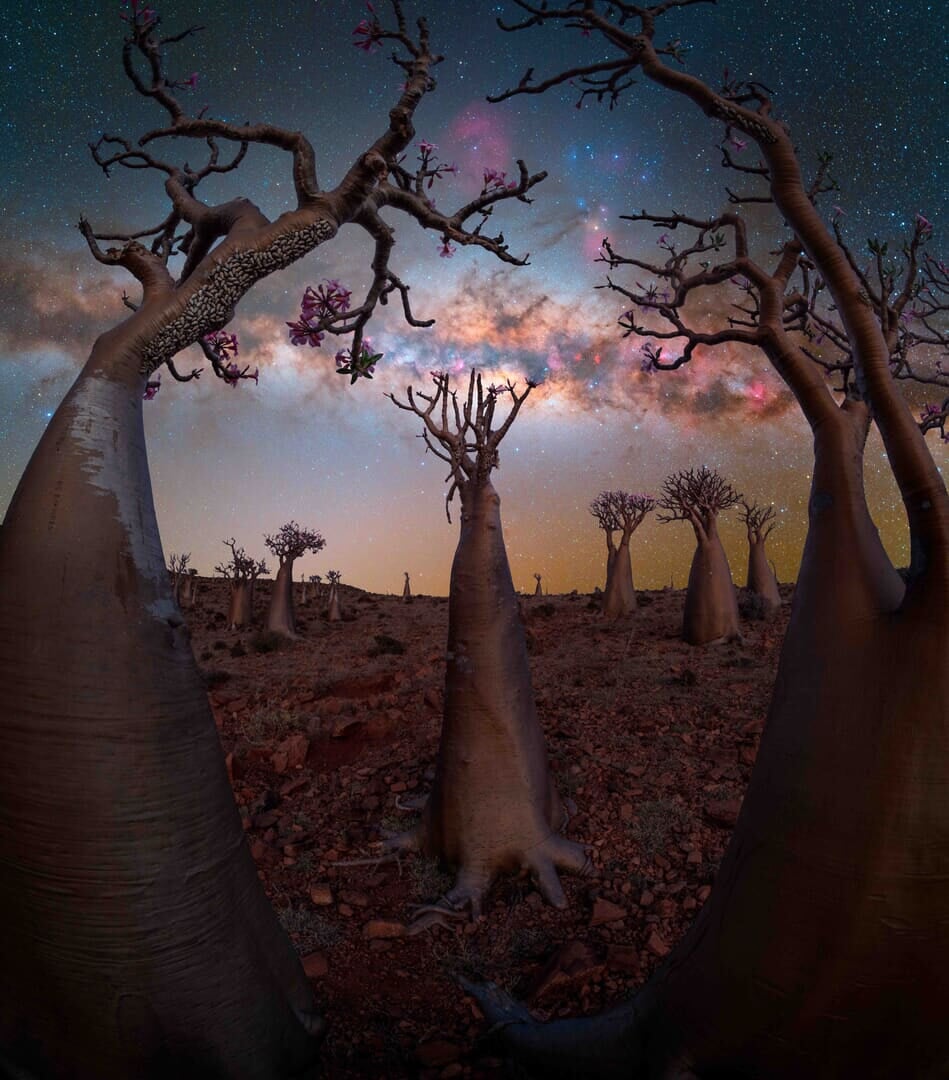
“Bottle Tree Paradise” – Benjamin Barakat
- Socotra, Yemen
Socotra is one of my favorite places on Earth, but when it comes to a specific location, this one stands out. It doesn’t have an official name, as it’s not a destination for the few fortunate tourists who visit Socotra. After shooting there for the past four years and scouting the island, I’ve discovered hidden gems like this one, which I call Bottle Tree Paradise.
Bottle trees are unique to Socotra, a result of the island’s long isolation from the mainland. This separation allowed them to evolve distinctive features, such as their water-storing, bottle-shaped trunks, which help them survive Socotra’s harsh, dry climate. They are believed to have originated from ancient plant species that adapted to the island’s unique environment over millions of years.
Foreground (blue hour): 10 seconds, f/8, ISO 400
Sky: 5x 120 seconds, f/2.0, ISO 400
“Double Milky Way Arch Over Matterhorn” – Angel Fux
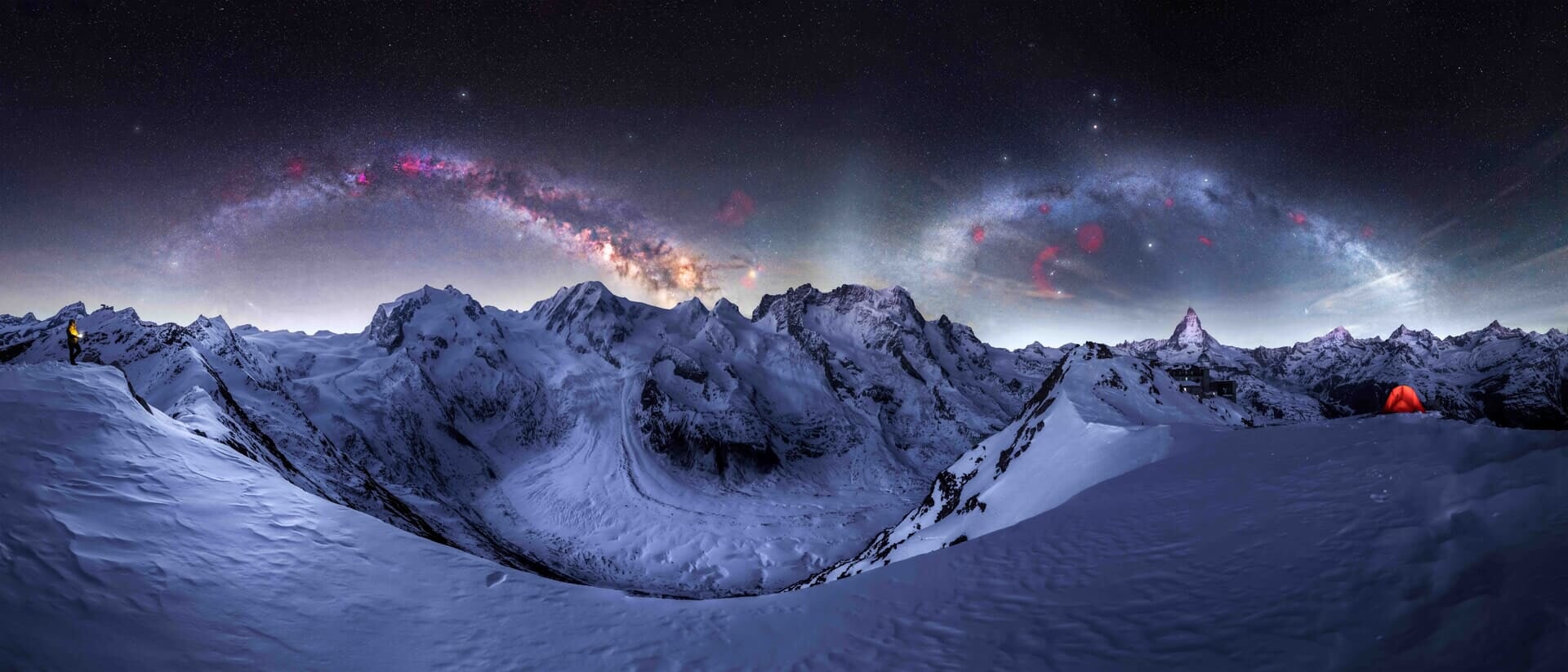
“Double Milky Way Arch Over Matterhorn” – Angel Fux
- Zermatt, Switzerland
This image captures the rare Double Arch Milky Way, where both the Winter Milky Way (with Orion rising) and the Summer Milky Way (with the Galactic Center) appear in the same night—a seamless transition between seasons.
Taken at 3,200 meters in the heart of winter, the night was brutally cold, testing both my endurance and equipment. This is a time blend, preserving the real positions of both arches by combining frames taken hours apart, with the foreground captured at dawn for the best detail.
Zermatt and the Matterhorn have been photographed countless times, but I aimed to create something truly unique—an image captured under conditions few would attempt. I’m incredibly proud of the effort and patience it took to bring this vision to life.
Both arches share the same EXIF: 20mm, f/5.6, 127sec, ISO 2500.
Foreground / Landscape: 15.5mm, f/5, 1/5sec, ISO 800
- Nikon Z6 Astromodified (for the sky part)
- NIKKOR Z 20mm f/1.8
- Nikon Z8 (for the landscape part)
- NIKKOR Z 14-24mm f/2.8
- Benro Polaris Astro Kit
- Peak Design travel tripod
“Valle de los Cactus” – Pablo Ruiz
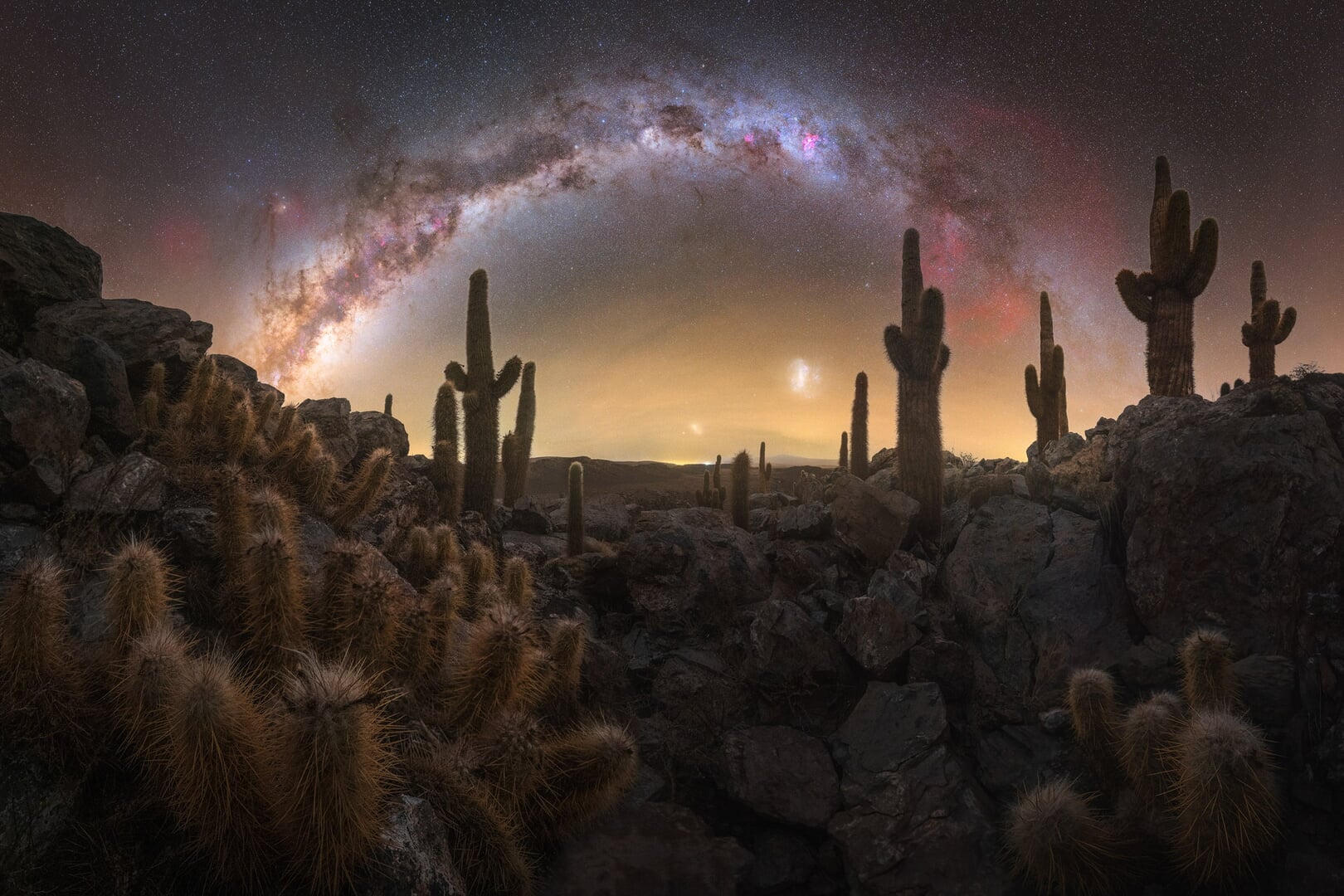
“Valle de los Cactus” – Pablo Ruiz
- San Pedro de Atacama, Chile
A panoramic shot of the Milky Way in a remote area of the Atacama Cactus Valley, known for its large concentration of cactus plants. I love this place with its countless possibilities. The panorama was taken just as the galactic center began to rise, with the spectacular Gum Nebula visible on the right.
It was an especially bright night with a breathtaking sky. The valley isn’t easy to navigate, but it’s always worth trying to find new compositions in such stunning locations beneath the night sky.
Sky: 9 x 240 sec, ISO 800, 14mm, f2.8
Foreground: 9 x 120 seg, ISO 2500, 14mm, f2.8
“Cosmic Fire” – Sergio Montúfar
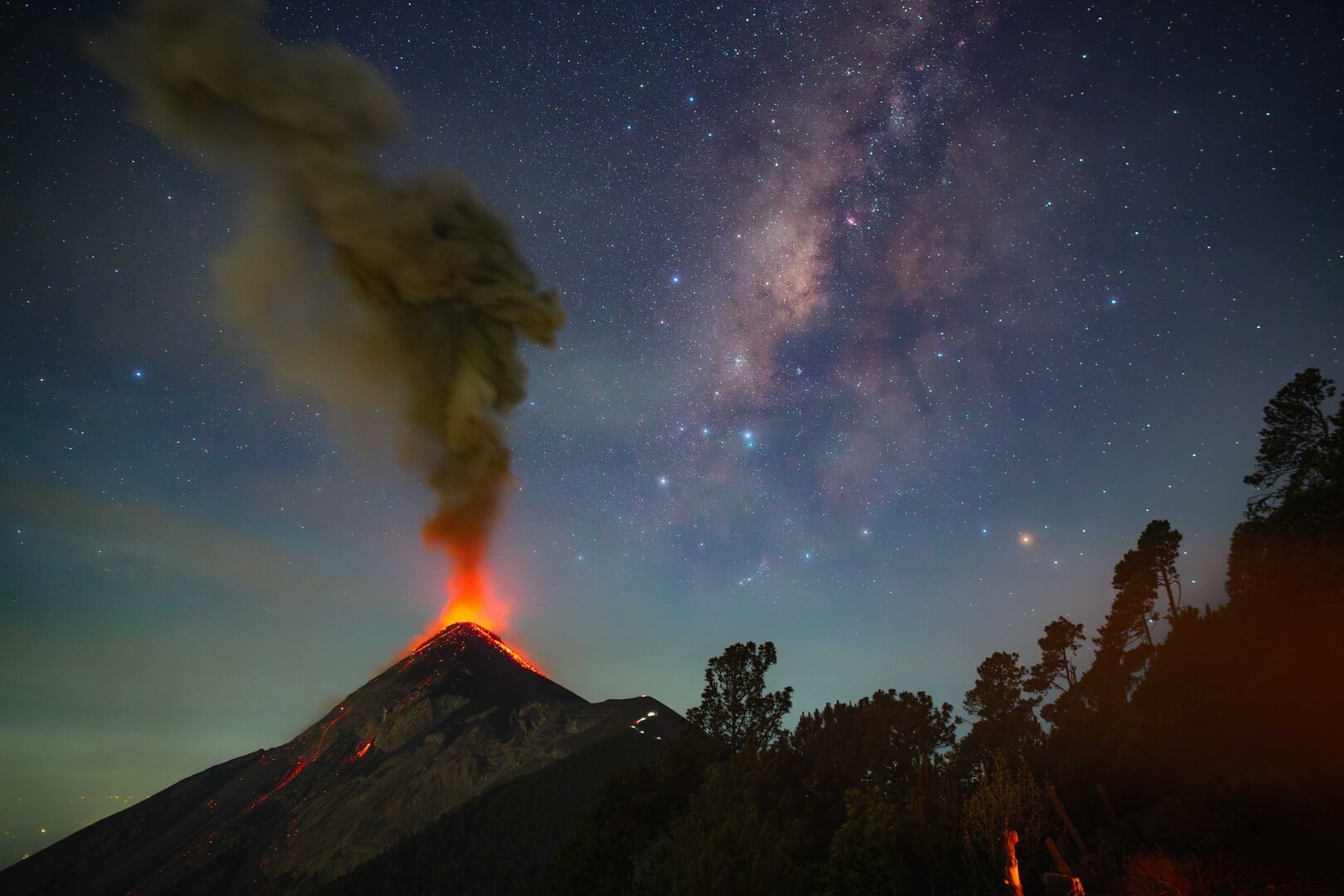
“Cosmic Fire” – Sergio Montúfar
- Volcán Acatenango, Guatemala
On the early morning of June 2, 2024, I summited Acatenango Volcano for the first time, hoping to witness the fiery beauty of the neighboring Volcan de Fuego against the Milky Way’s backdrop. That night, the volcano was incredibly active—each thunderous explosion reverberated in my chest, while glowing lava illuminated the dark slopes. Above, the Milky Way stretched diagonally across the sky, a mesmerizing band of stars contrasting with the chaos below. As the volcano erupted, the ash plume rose vertically, forming an acute angle of about 45 degrees with the galaxy’s diagonal path, creating a stunning visual contrast between Earth’s fury and the cosmos’ serenity.
Capturing this required a fast, wide-angle lens (f/2.8), an ISO of 3200, and a 10-second exposure to balance the volcanic glow with the starlight. The challenge was timing the shot during a new moon and aligning the right moment for the Milky Way to cross the frame next to the volcano. I used Lightroom as the editor. This image is special for its storytelling—the raw power of Volcan de Fuego meeting the tranquil expanse of the galaxy.
Single 10 sec / iso 3200 / f2.8
- Canon 6d Astromodified
- Samyang 24mm f1.4
- Sirui tripod
“A Sea of Lupines” – Max Inwood
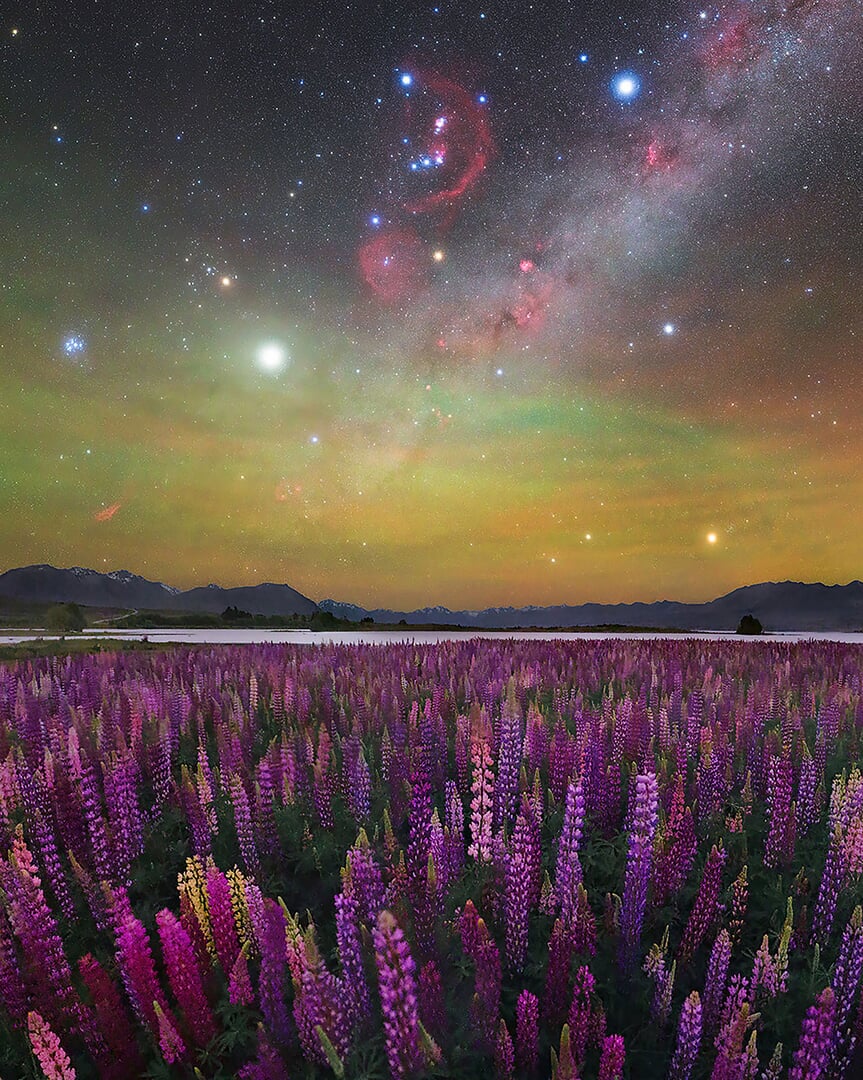
“A Sea of Lupines” – Max Inwood
- Lake Tekapo, New Zealand
The annual lupine bloom in New Zealand is spectacular, with fields of colorful flowers stretching across the Mackenzie Basin. This region, located in the heart of the South Island, is renowned for its dark skies, making the scene even more surreal at night.
I had to wait until the early hours of the morning for the wind to calm down, but eventually everything became still, and I was able to capture this image. Above the flowers, you can see the band of the outer Milky Way, alongside the constellations Orion, Gemini, and the Pleiades. Joining them are the bright planets Jupiter and Mars, with a strong display of green airglow visible along the horizon.
Sky: 30s, f/2.0, ISO 3200
Foreground: 30s, f/2.4, ISO 6400
GET THE CALENDAR WITH THE BEST DATES TO PHOTOGRAPH THE MILKY WAY IN 2025
You’ll also receive our PDF guide to photographing the Milky Way!
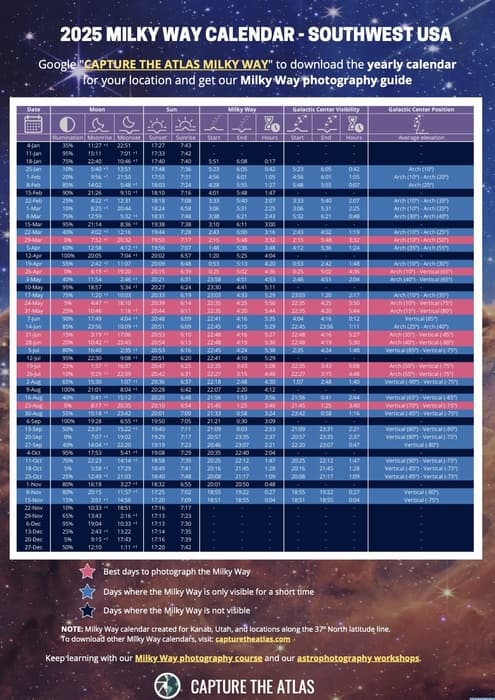
“Diamond Beach Emerald Sky” – Brent Martin
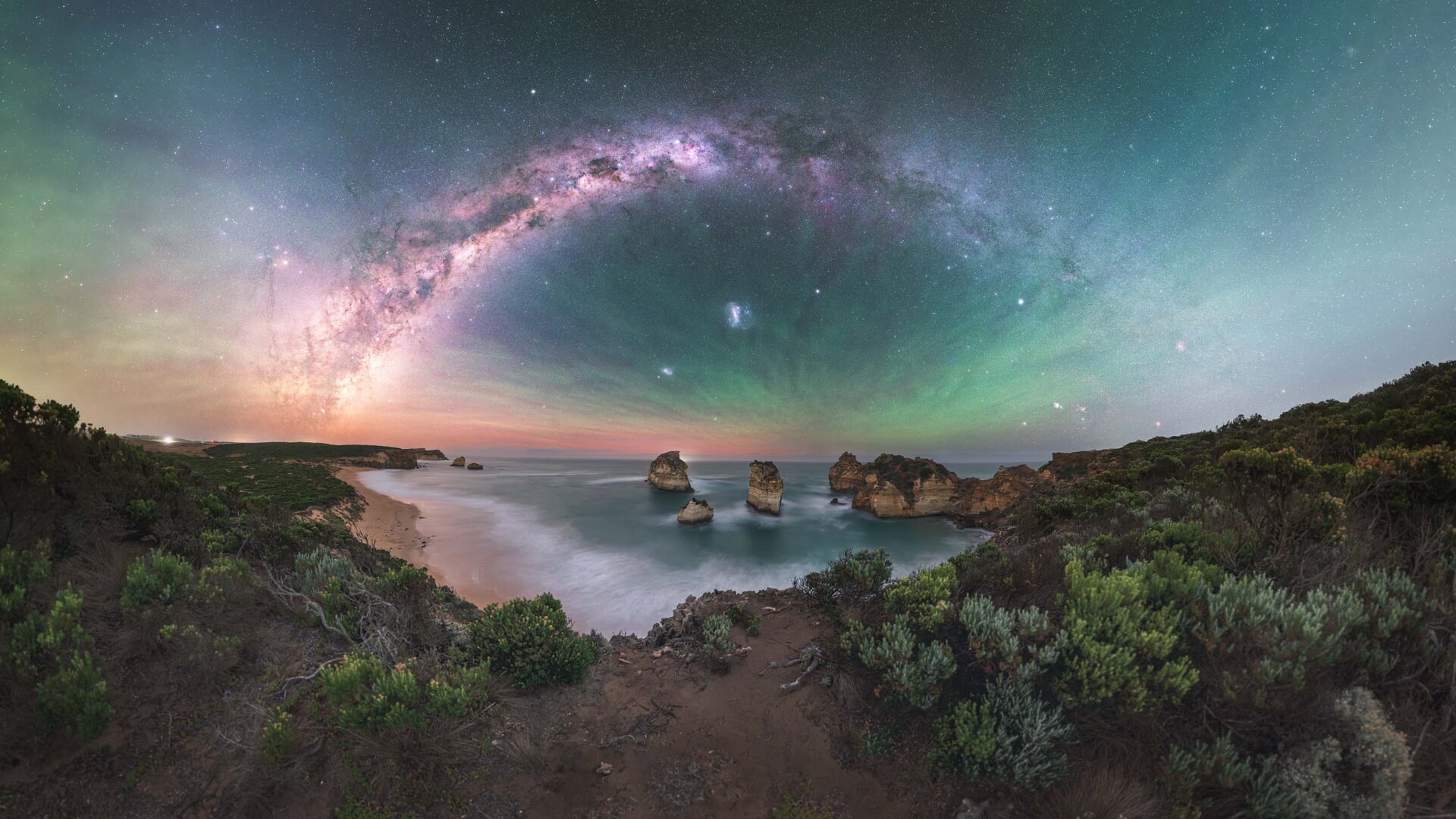
“Diamond Beach Emerald Sky” – Brent Martin
- Great Ocean Road, Australia
With a clear night forecast and the Milky Way core returning for 2025, I set out to explore the Great Ocean Road. After a few setbacks—such as a failed composition and getting the car stuck on a sandy track—I almost gave up. However, I pushed on and found a great spot above the beach to capture the scene.
The night was full of color, with Comet C/2024 G3 Atlas and a pink aurora in the early hours, followed by the Milky Way rising amid intense green airglow near dawn. Despite the challenges, the reward of this stunning image and the memory of the view made it all worthwhile.
Sky: 13 frames x 3 rows, @ 20mm, f/3.5, iso-1600, 60 second tracked exposures.
Foreground: 13 frames x 2 rows, @ 20mm, f/2.5, iso-1600, 60 second exposures.
- Sony A7III Astromodified
- Sony 20mm f/1.8 G
- Sky-watcher Star Adventurer 2i
“Blossom” – Ethan Su
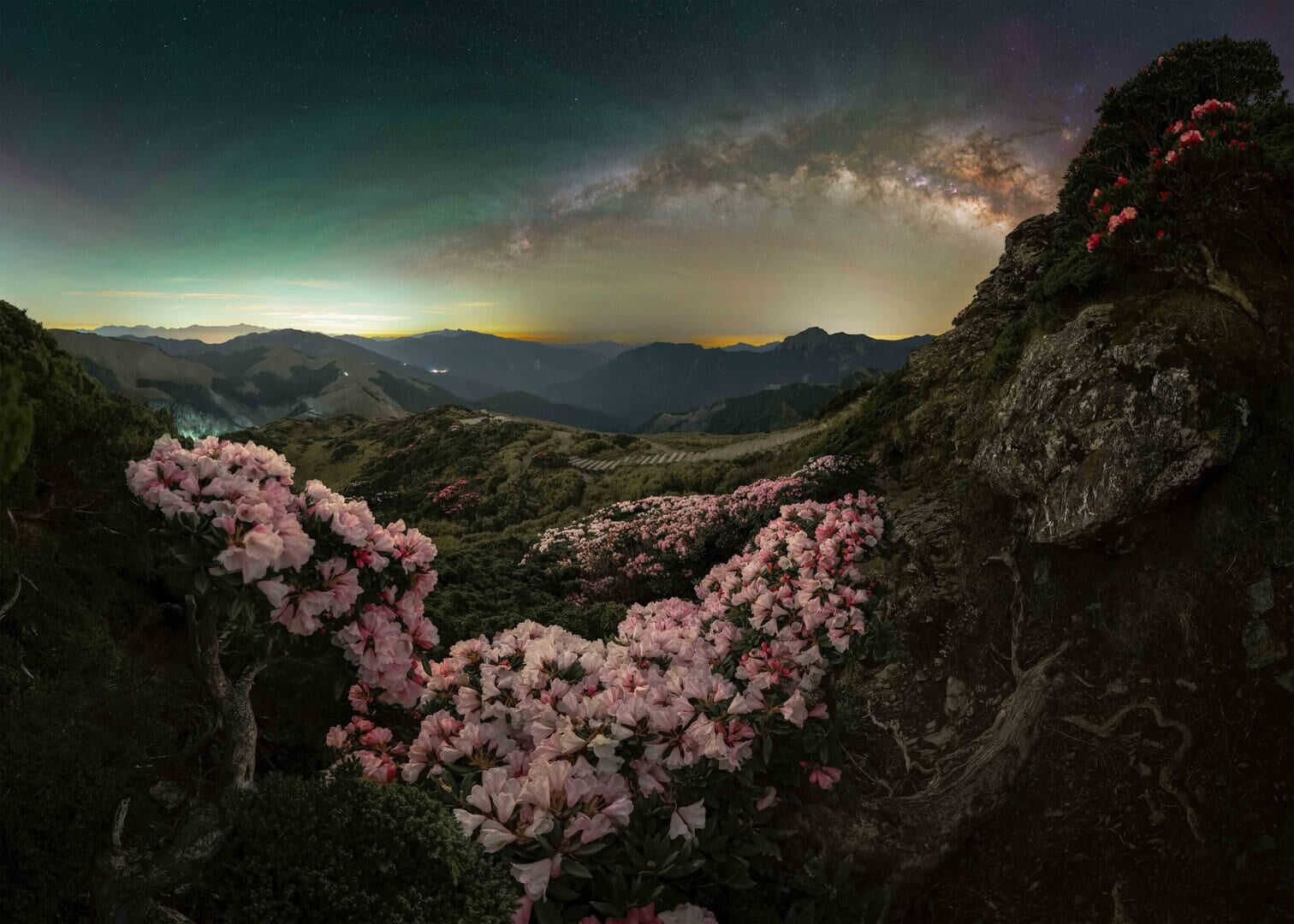
“Blosoom” – Ethan Su
- Hehuan Mountain Dark Sky Park, Taiwan
After three years of waiting, the Yushan alpine rhododendrons are finally in bloom once again on Taiwan’s 3,000-meter-high Hehuan Mountain. On this special night, distant clouds helped block city light pollution, revealing an exceptionally clear view of the Milky Way. A solar flare from active region AR3664 reached Earth that evening, intensifying the airglow and adding an otherworldly touch to the sky.
Together, these rare natural events created a breathtaking scene—vivid blooms glowing softly beneath a star-filled sky.
Sky: 1 row tracked panorama at f2/90sec/ISO800
Foreground: 2 row panorama and focus stack, f2.8/60sec/ISO6400; 65 images in total.
- Sony A7III Astromodified
- Sigma 20mm f/1.4 DG DN Art
- Vixen Polarie U
- Leofoto LS-284cex tripod
“The Night Guardians” – Rositsa Dimitrova
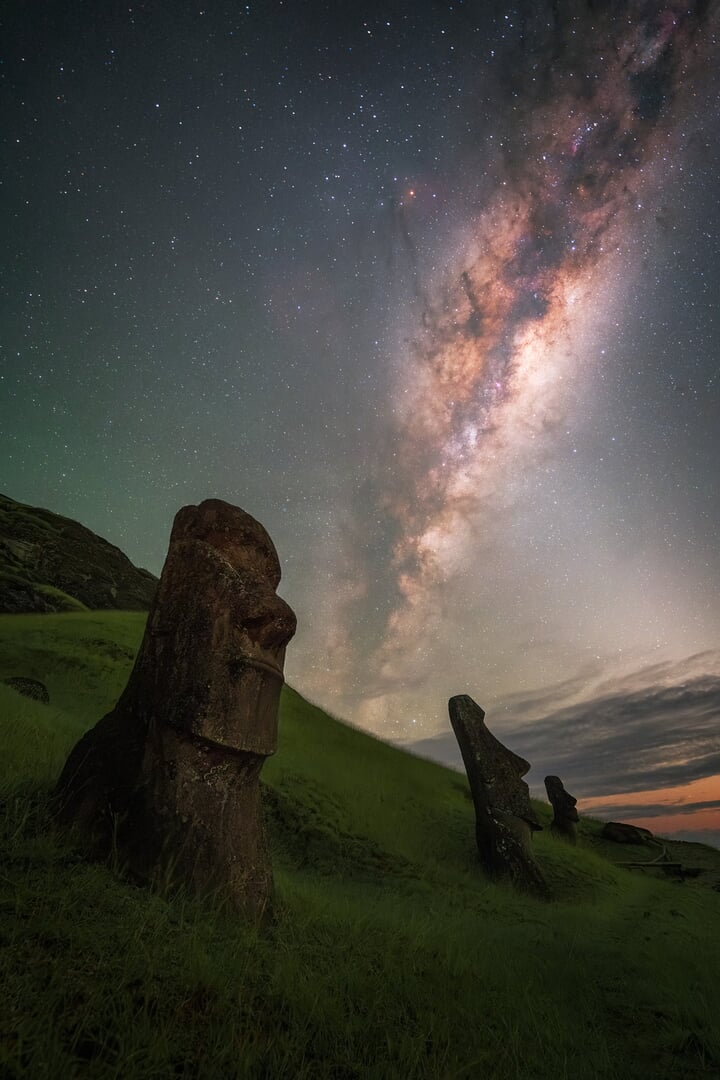
“The Night Guardians” – Rositsa Dimitrova
- Easter Island, Chile
Easter Island had been on my bucket list for a long time, and it once seemed almost impossible to reach. On our first night there, the weather forecast looked promising, so we decided to go ahead with the tour our group had booked 4–5 months earlier. However, Rapa Nui sits in the middle of the Pacific Ocean, where the weather is notoriously unpredictable. When we woke up at 3 a.m. in our hotel, the sky was completely covered in clouds. Still, we decided to take the risk, knowing the forecast for the next few nights was even worse.
An hour later, we were frantically photographing the statues at Rano Raraku—the quarry where nearly all of the island’s 900 statues were carved—when the sky suddenly began to clear. By 5 a.m., it was completely clear, and we had less than two hours to capture all the shots we wanted. We felt incredibly lucky to be in the right place at the right time.
Blend of 2 shots: foreground: 88 seconds, f/3.5, ISO 3200; sky: 20 seconds, f/2.0, ISO 2000
- Sony A7iii Astromodified
- Sony GM 14/1.8
“Fortress of Light” – Mauricio Salazar
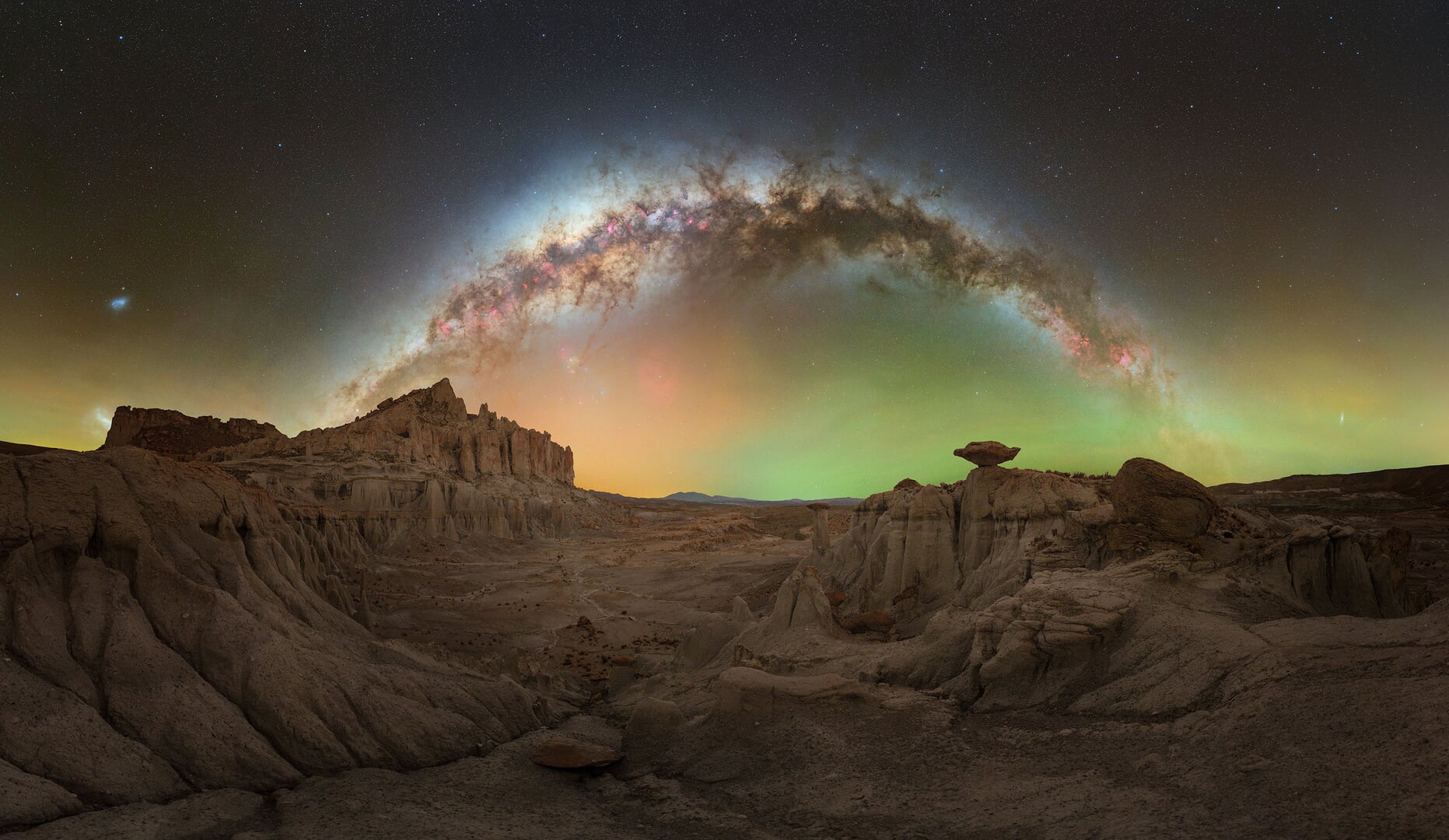
“Fortress of Light” – Mauricio Salazar
- Jujuy, Argentina
Since I started shooting the night sky, I’ve always sought out landscapes that feel like they belong to another planet — remote, untouched, and far from light pollution. That’s exactly what I found in “The Cathedral,” a surreal rock formation in Jujuy, Argentina.
Photographing at over 4,000 meters (13,000 feet) presented its challenges, but when I arrived and saw the rock formations, I was completely blown away. The landscape felt like something from a fantasy world, and the towering cliffs instantly reminded me of a giant stone fortress sculpted by nature.
As twilight gave way to full darkness, the core of the Milky Way appeared high overhead, shining with incredible clarity. I patiently waited as the galactic center slowly descended toward the horizon, perfectly aligning above the cliffs.
While capturing the panorama, the camera picked up bands of orange and green airglow, adding a unique glow to the horizon.
This image captures everything I love about photographing the Milky Way — the silence of remote places, the peace of standing under a pristine sky, and the deep connection I feel to the moment, fully present and grateful to witness it.
Sky Panorama: 20mm, f/1.8, 30 sec, ISO 1600 — 5 tracked and stacked photos per panel for noise reduction.
Foreground Panorama: 14mm, f/2.8, 90 sec, ISO 1600 per panel.
“Glimpse of colors” – Tomas Slovinsky
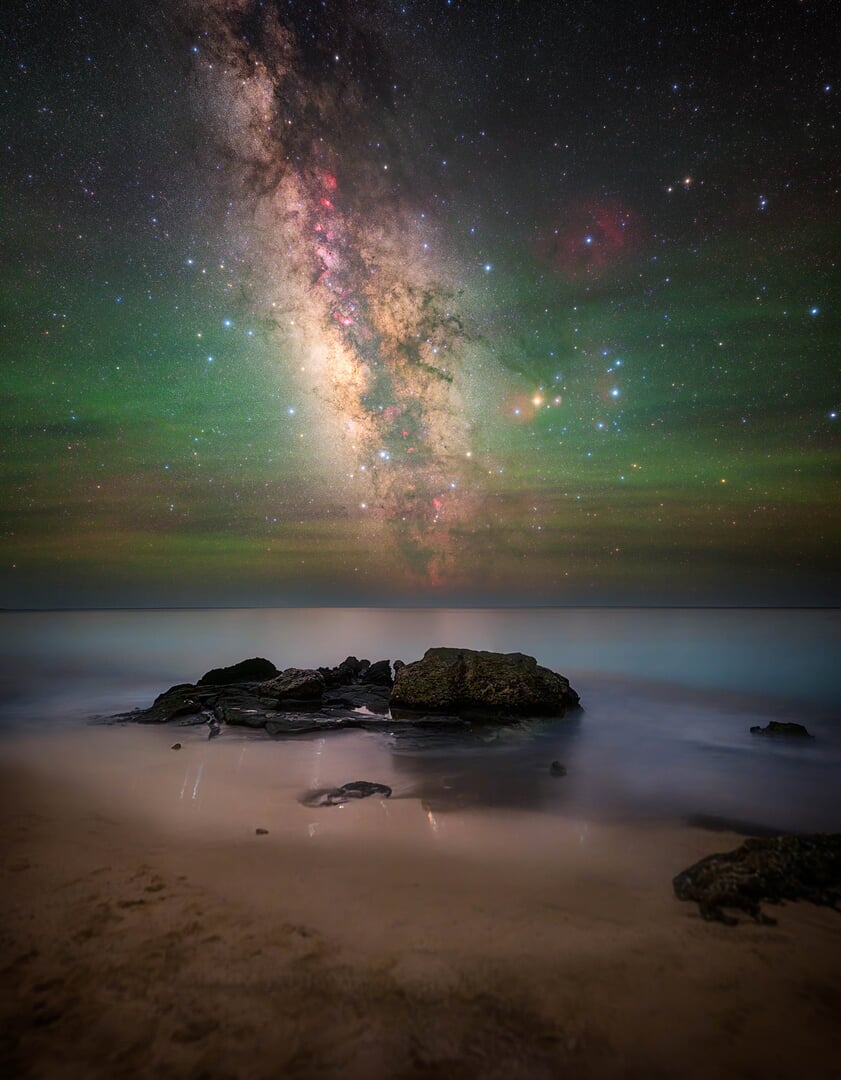
“Glimpse of colors” – Tomas Slovinsky
- South Crete, Greece
Nature is truly amazing, creating breathtaking scenery that leaves us speechless. I took this picture during my last astrophotography workshop in Crete. With pleasant temperatures around 25°C, I spent my time lying on the beach, listening to the sound of the waves, and gazing at the sky, completely free from light pollution.
The sky was covered in thousands of stars, with the Milky Way reflecting on the surface of the sea—an experience that felt like a dream. Even the airglow was visible to the naked eye. Thanks to the camera, all the beautiful colors came to life.
20″, f/2.5, ISO 3200
- Canon R6 Astromodified
- Sigma Art 50mm
- MSM Nomad tracker
- Leofoto tripod
“Evolution of Stars” – Kavan Chay
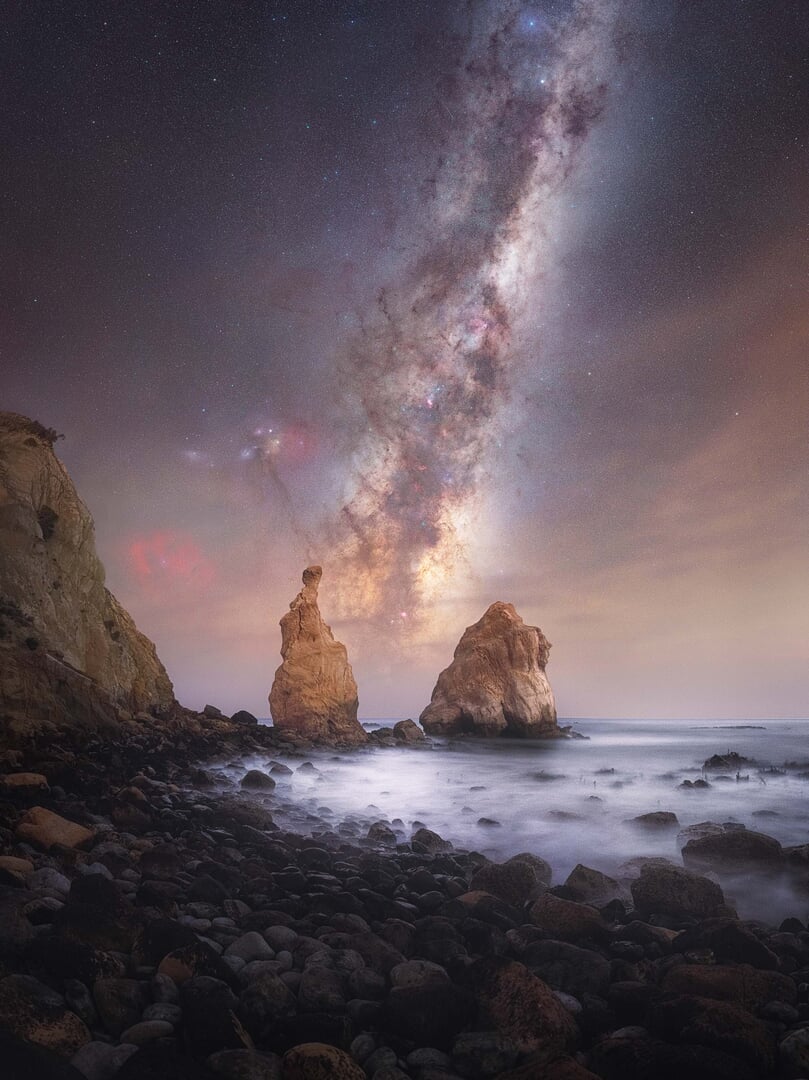
“Evolution of Stars” – Kavan Chay
- Otago, New Zealand
The first image I captured from this spot is the one I feel truly kickstarted my astrophotography journey years ago. It was the first time I shot a tracked panorama using a “longer” focal length lens (50mm). The set of sea stacks provided a prominent foreground subject facing the right direction, and being a local spot relatively free of light pollution, it was the perfect location to capture the Milky Way core.
It felt fitting to try again with a few extra years of experience and an astro-modified camera, which allows for easier capture of hydrogen-alpha-rich regions of the sky (like the reddish nebulae around Zeta Ophiuchi, as seen in the image). The years of experience certainly made panoramic shooting and editing easier, though the shoot wasn’t without its challenges.
I managed to drop a tiny screw adapter in the dark, so I had to improvise a quick solution to make use of the star tracker. With a dying headlamp and the mysteries of wildlife lurking in the dark, all while the tide rapidly rose, it felt like enough adventure for a weekday night.
Sky RGB: 4 frames x 3 rows, each shot at 40mm, f1.8, ISO1250, 50 second exposures.
Sky (Rho region): Stack of 10 frames, each shot at 40mm, f1.8, ISO1250, 60 second exposures.
Foreground: 4 frames x 3 rows, each shot at 40mm, f4, ISO2000, 60 second exposures.
- Nikon Z7 (astromodified)
- Sigma Art 40mm f1.4
- Benro GX-35 ballhead
- Sirui AM-254 tripod legs
- Sky-Watcher Star Adventurer Pro 2i
“The Wave” – Luis Cajete
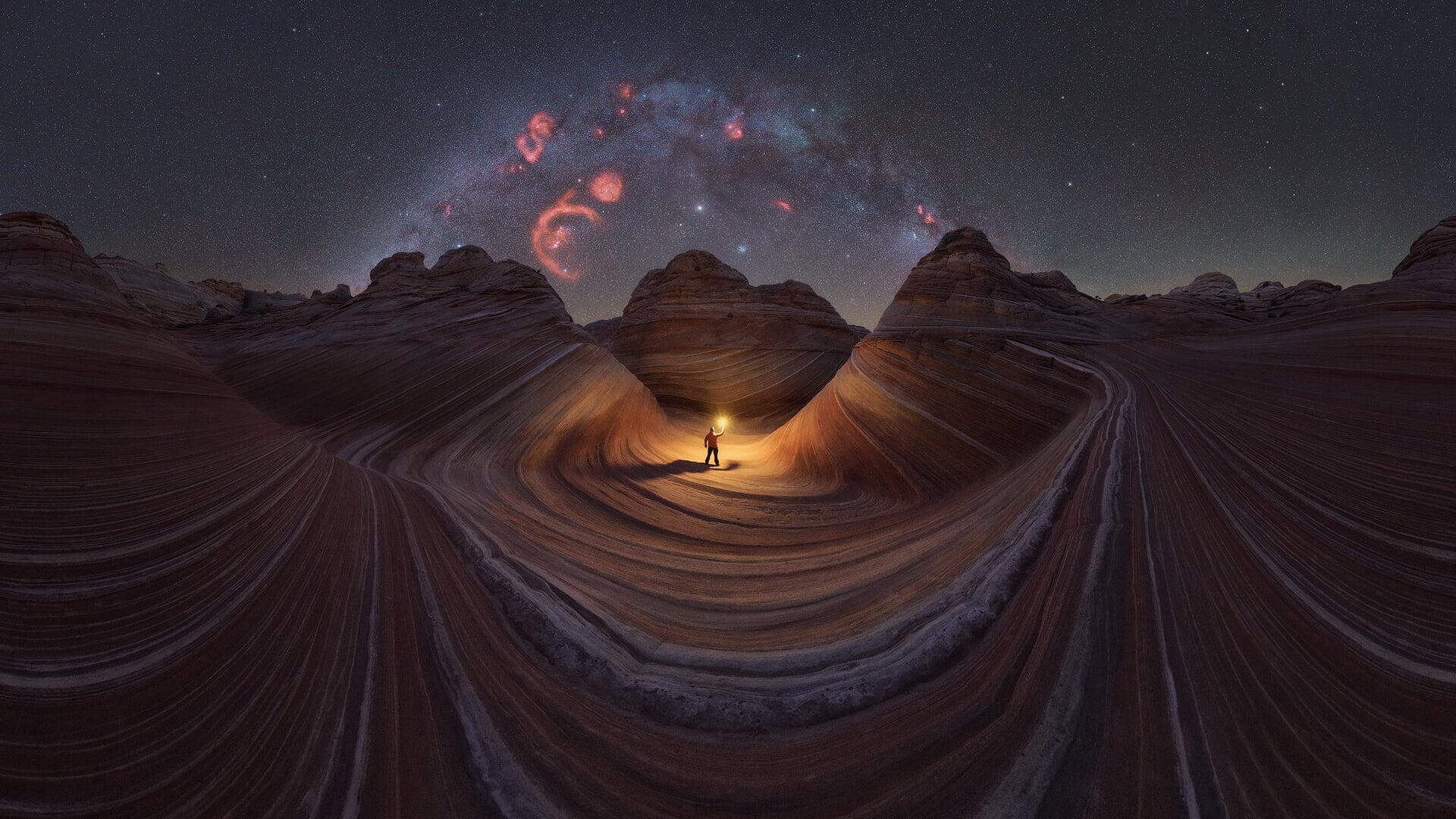
“The Wave” – Luis Cajete
- Coyote Buttes, UT, USA
One of my greatest passions is visiting stunning natural wonders and paying my personal tribute to them through night photography. This image was taken at Coyote Buttes, a geological masterpiece located in Arizona, where special access permits are required to protect it for future generations.
Despite the intense cold during those days, it was incredibly exciting to visit the great sandstone wave for the first time and enjoy its spectacular shapes and colors.
To capture this 360° panorama, I planned for the Milky Way and focused on creating a balanced photographic composition. It’s hard to put into words the beauty of this place, but I hope my photograph manages to convey it.
Foreground: 360° panorama, two rows, 8 sec f/3.5 ISO 6400
Sky: 360° panorama, two rows, 60 sec f/1.8 ISO 800
Sky H Alpha: three-shot panorama, stacked, 240sec f/1.8 ISO 1600
“Winter Fairy Tale” – Uroš Fink
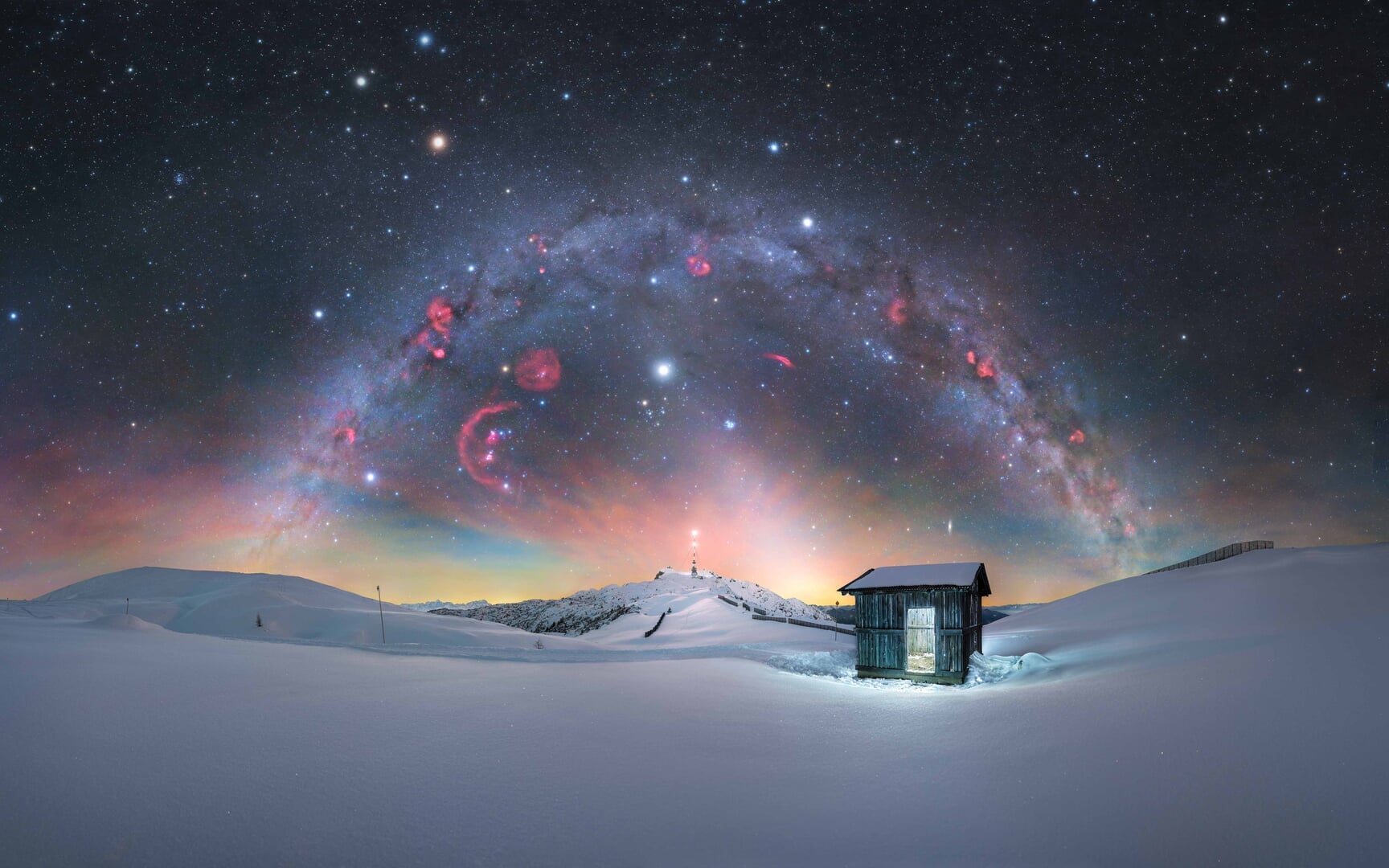
“Winter Fairy Tale” – Uroš Fink
- Dobratsch Nature Park, Austria
Undoubtedly my wildest location this winter: Austria’s Dobratsch mountain! If I had to describe it in two words, it would be a “Winter Fairytale”!
Despite a 5 a.m. work shift, I drove to Austria by 1 p.m., worried about my fitness and lack of sleep. After a 2-hour hike through the snow with a 22kg backpack and sled, the stunning views kept me energized.
Arriving at the cabin (where I had planned my winter panorama two years ago), I was greeted by untouched snow, completely free of footprints. I spent the evening exploring compositions, and this is my favorite: a panorama of the winter Milky Way with reddish nebulae, stretching above Dobratsch Mountain.
I captured the Zodiacal light and even the Gegenschein glow! The sky was magnificent, with Jupiter and Mars shining brightly. In the foreground is the cabin, where I spent 3 freezing hours (-12°C), waiting for the perfect shot of the Milky Way’s core. It turned out exactly as I envisioned—a true winter fairytale.
Sky: ISO 800, f1.8, 90s, 8 panels, low exposure frames for brighter sky parts (30s) + lee soft 5 for stars (ISO3200, f1.8, 20s)
Foreground: ISO 1250, f2.2, 80s, 8 panels + multi exposure frames for lightning the hut (80s, 20s,10s,5s,2s,1s)
- Nikon Z
- Sigma 20mm 1.4 Dg Dn
- Megadap tze21
- Fornax Lightrack 2i
- Sunwayfoto t3240ck
- Lee soft 5 filter for stars
- Focus on star mask
“Galaxy of the Stone Array” – Alvin Wu
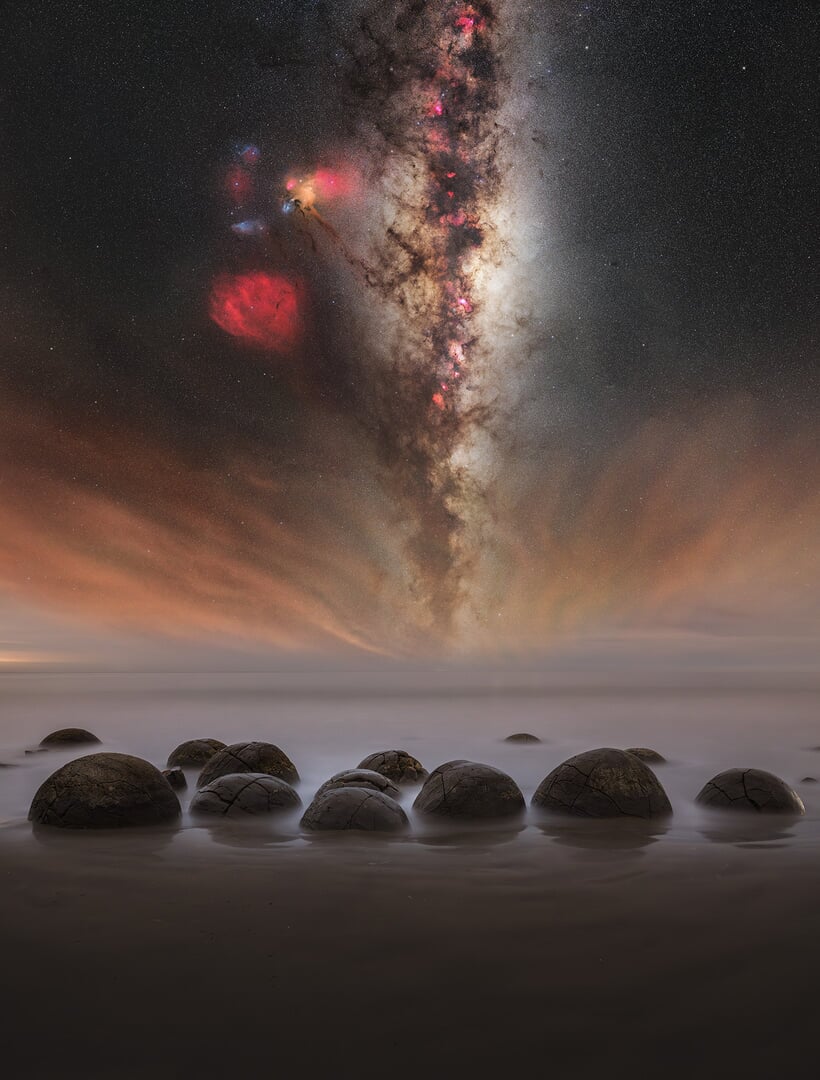
“Galaxy of the Stone Array” – Alvin Wu
- Moeraki Boulders, New Zealand
The Milky Way hangs over the sea. The night sky of the Southern Hemisphere condenses the poetry of Li Bai, a poet from China’s Tang Dynasty, into eternity. On a clear night, the Milky Way pours down over the sea like a waterfall from the sky, intertwining with the atmospheric glow on the water’s surface.
Sky: 40mm, 60s x 9 pano
Foreground: 24mm, 120s
“Echiwile Arch” – Vikas Chander
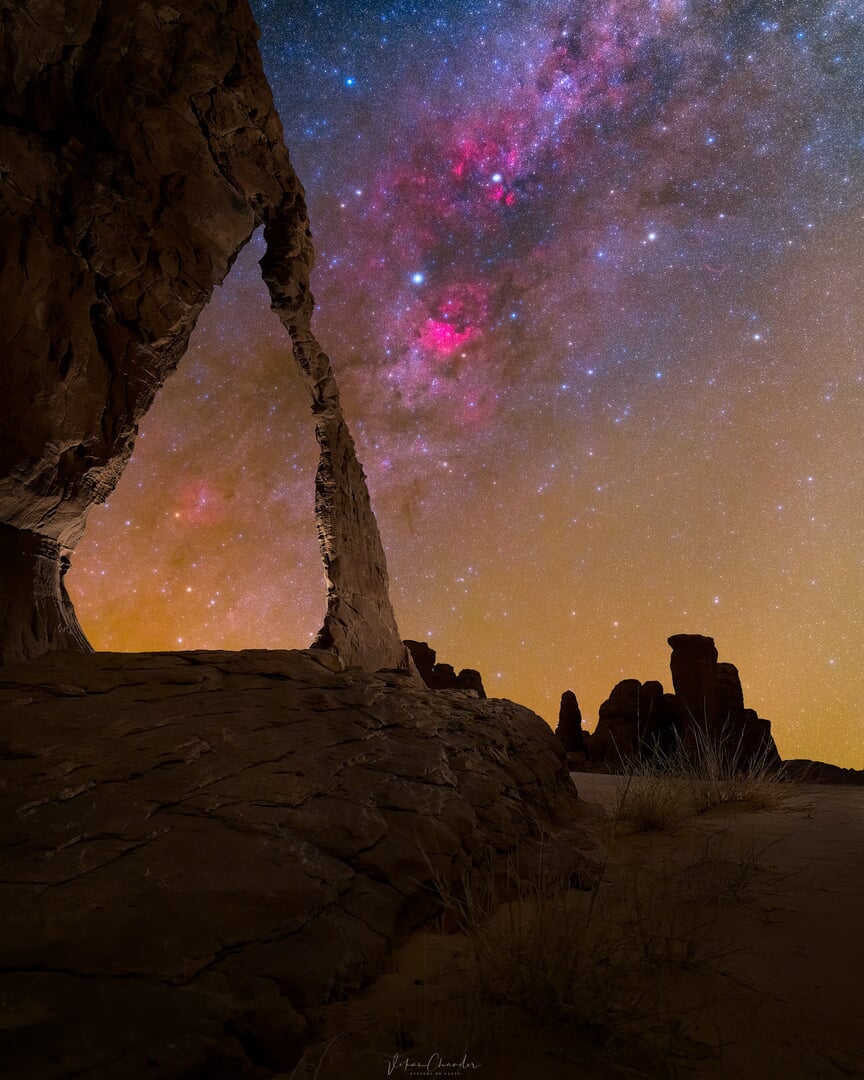
“Echiwile Arch” – Vikas Chander
- Ennedi, Chad
When one first Googles information about visiting Chad, the results aren’t very encouraging from a safety perspective. Nevertheless, the intrepid astrophotographer in me decided to take the chance and visit this landlocked country, specifically the Ennedi Massif in the north.
Sparsely populated and completely devoid of light pollution, the three-day drive from the capital, N’Djamena, was well worth the troubles and risks involved. The region is filled with numerous rock formations, shapes, and arches, offering an abundance of options for foreground elements to frame the dramatic night skies. Seen here is a small arch in the shape of a hoof in the Ennedi region.
Sky Exposure: 300secs, F2.8, iso 800, stack of 6
Foreground exposure:480secs, F2.8, ISO 800, LENR, LLL
Software: Pixinsight and Photoshop
- Sony A7rV Ha modded
- Sony 12-24 F2.8 GM
- Rainbow Astro RST 135e
“Universo de Sal” – Alejandra Heis
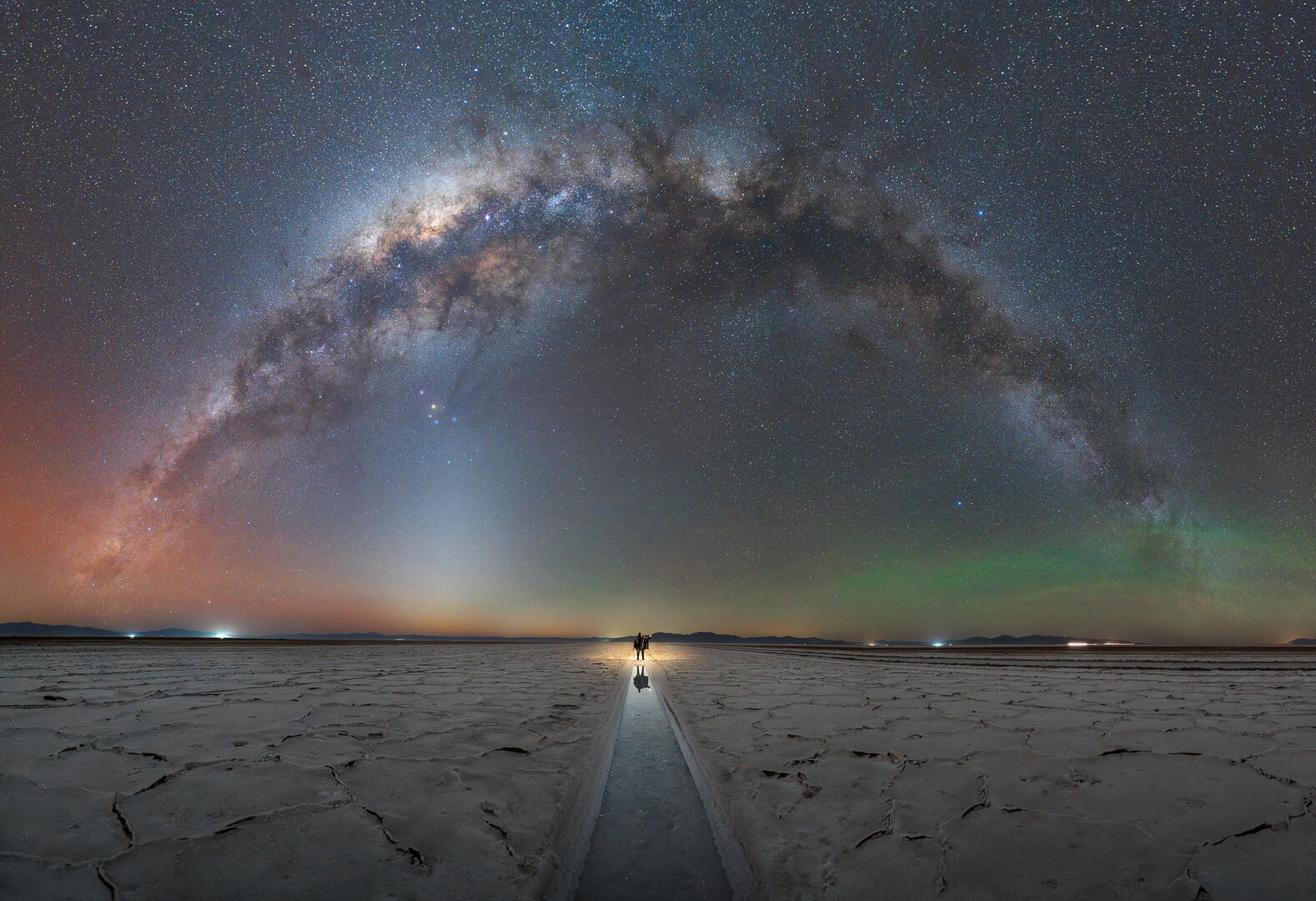
“Universo de Sal” – Alejandra Heis
- Jujuy, Argentina
Some time ago, I set out to travel across my country, Argentina, and visit its most iconic places—but I wanted to show them in a different way. I believe I haven’t truly experienced a place until I see it at night. Nighttime feels more intimate, mysterious, and adventurous—a moment when the senses sharpen and you connect with your surroundings in a deeper way.
Salinas Grandes was one of those places I needed to capture at night. Sitting at about 3,500 meters above sea level, spending the night there was a real challenge. As night fell, I ventured deep into the vast salt flats, reaching the ponds where salt is extracted. Suddenly, the wind calmed and the air grew heavy, creating a strange yet captivating atmosphere. The sky put on an incredible show—the Milky Way perfectly positioned, airglow coloring each horizon in different shades. I couldn’t have asked for more. I allowed myself time to take the photo and simply soak in the beauty of nature’s gift.
Two-row panorama with five single-shot panels per row. 10″, f/1.8, ISO 5000
“Lake RT5” – Tanay Das
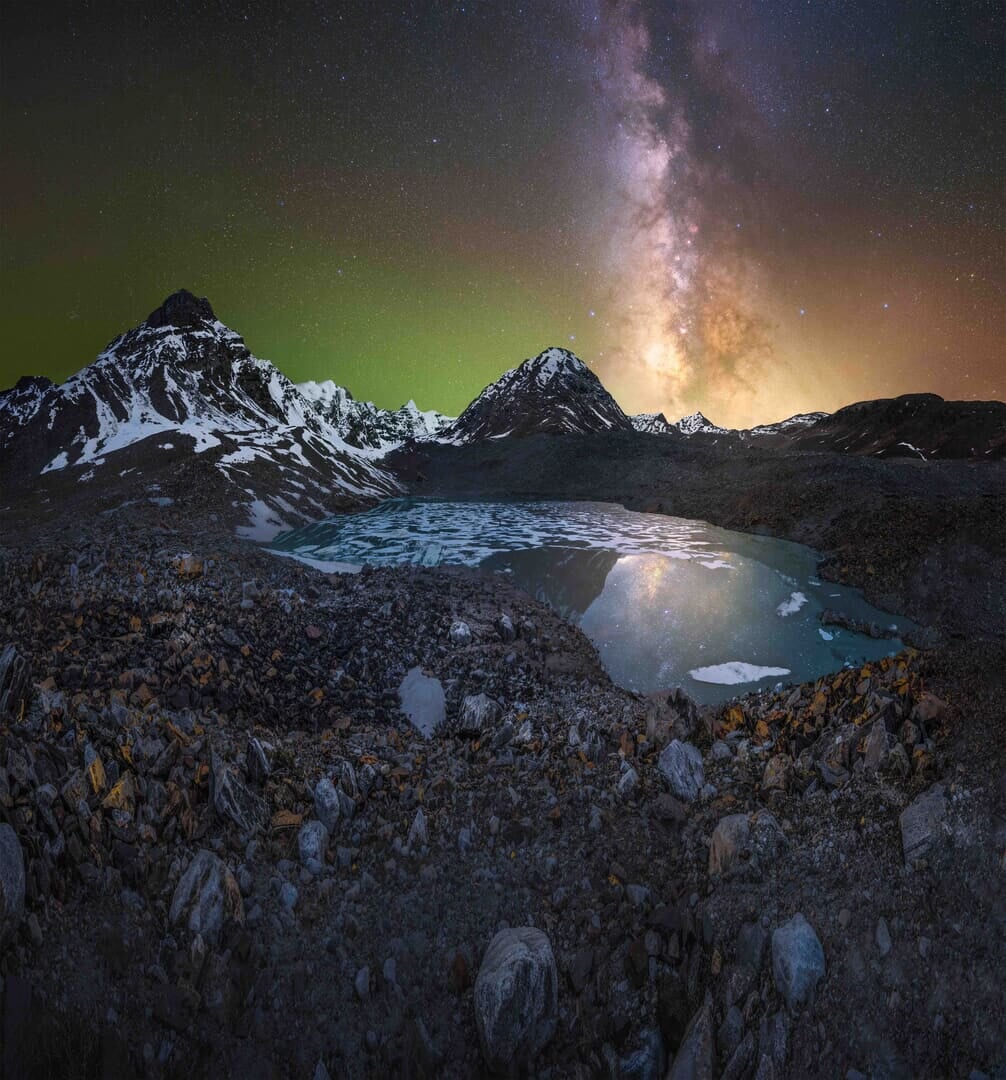
“Lake RT5” – Tanay Das
- Zanskar, Himalayas
Lake RT5 is a pristine alpine lake nestled at 5,700 meters above sea level. My passion has always been to capture the unseen Himalayas in their rawest form. This journey led us through rugged mountains and glaciers, where we discovered several unknown alpine lakes and named them along the way.
We endured multiple nights in extremely cold, unpredictable conditions. Due to the ever-changing weather and limited time, I used a blue hour blend to achieve a cleaner foreground. Since my campsite was right beside the lake, I was able to capture the tracked sky shot from the exact same position later that night.
I was in awe of the incredible airglow illuminating the Himalayan skies. The raw image had even more intense colors, but I toned them down to stay true to reality. This was undoubtedly one of the most unforgettable nights I’ve ever spent in the heart of the Himalayas.
Foreground: f/8, ISO 800, 600sec
Sky: f/4, ISO 2000, 120sec x 20 (tracked/stacked/blended)
“A Stellar View From The Cave” – Anthony Lopez
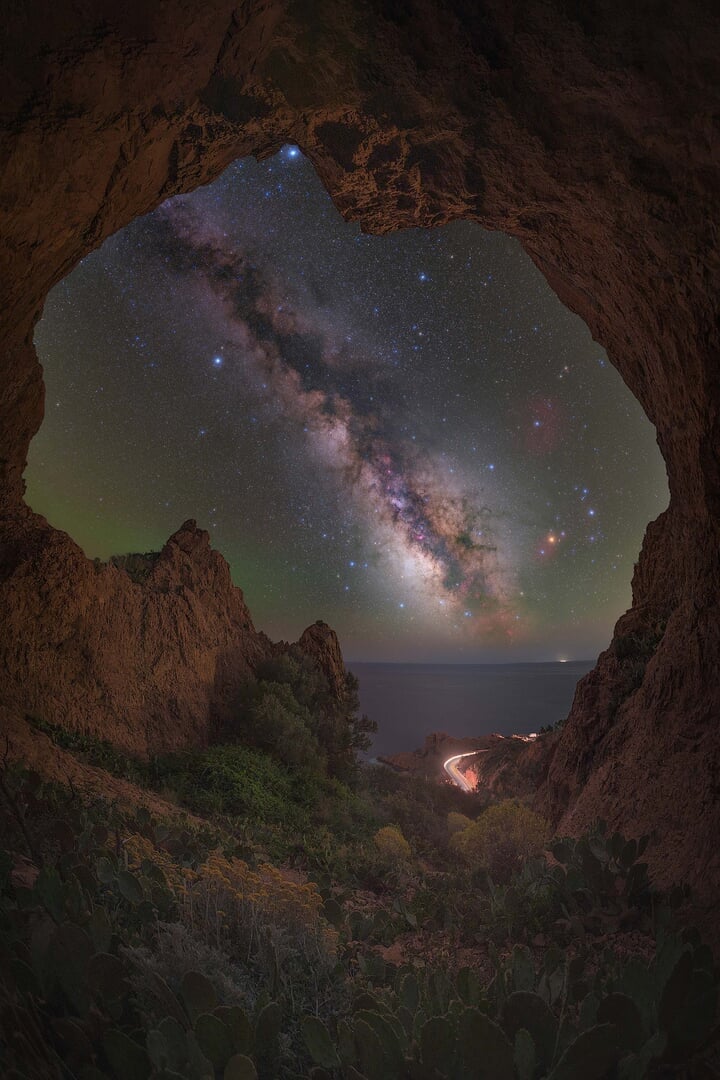
“A Stellar View From The Cave” – Anthony Lopez
- Saint Raphael, France
Framed by the rugged mouth of a coastal cave, this image captures the heart of the Milky Way rising over the Mediterranean Sea. Taken during the peak of the Galactic Core season last May, it blends the natural beauty of the foreground with the awe-inspiring vastness of the cosmos. A winding road, illuminated by passing cars, creates a dynamic trail of light that guides the eye toward the stars above.
This photo is a reminder that magic often hides in the most unexpected places. All it takes is a little patience, planning, and passion.
- SKY (landscape mode): 7 x 120sec F2.8 ISO 400 + 1 x 120sec F2.8 ISO 400 (Double Fog Filter on)
- HA: 5 x 120sec F2.8 ISO 2000
- FG: Panorama of 3 Rows of 120sec F2.8 ISO 800
“Spines and Starlight” – Burak Esenbey

“Spines and Starlight” – Burak Esenbey
- Kanaan, Namibia
On our second Namibia Photography Tour, we began our journey once again at one of our favorite spots in Kanaan. Last year was an incredible experience, but this time, we decided to explore more of this vast land.
During a scouting trip, I stumbled upon the perfect composition—two quiver trees standing tall with a large cactus in the foreground, all beautifully aligned with the Milky Way. I had always wanted to capture the Milky Way alongside a big cactus, so in that moment, it felt like a special gift.
Getting everything in focus was a bit challenging, as I had to get extremely close to the cactus without getting poked. To achieve perfect sharpness, I used focus stacking. Additionally, I shot with an astro-modified camera and a GNB Nebula filter to enhance the details of the night sky.
Foreground: 14mm, f4.5, 5 sec. at ISO 2500 – 8 Frames focus Stack
Sky RGB: 14mm, f2.5, 120 sec. at ISO 640 – 2 Frames
Sky HA/GNB: 14mm, f2.5, 181 sec. at ISO 3200 – 3 Frames
- Sony A7III Astro Modified
- Sony 14mm 1.8
- Sunwayfoto T3640CM Tripod
- MoveShootMove Nomad Sky Tracker
- GNB Filter
“Un Destello en la Oscuridad” – Luis Merino
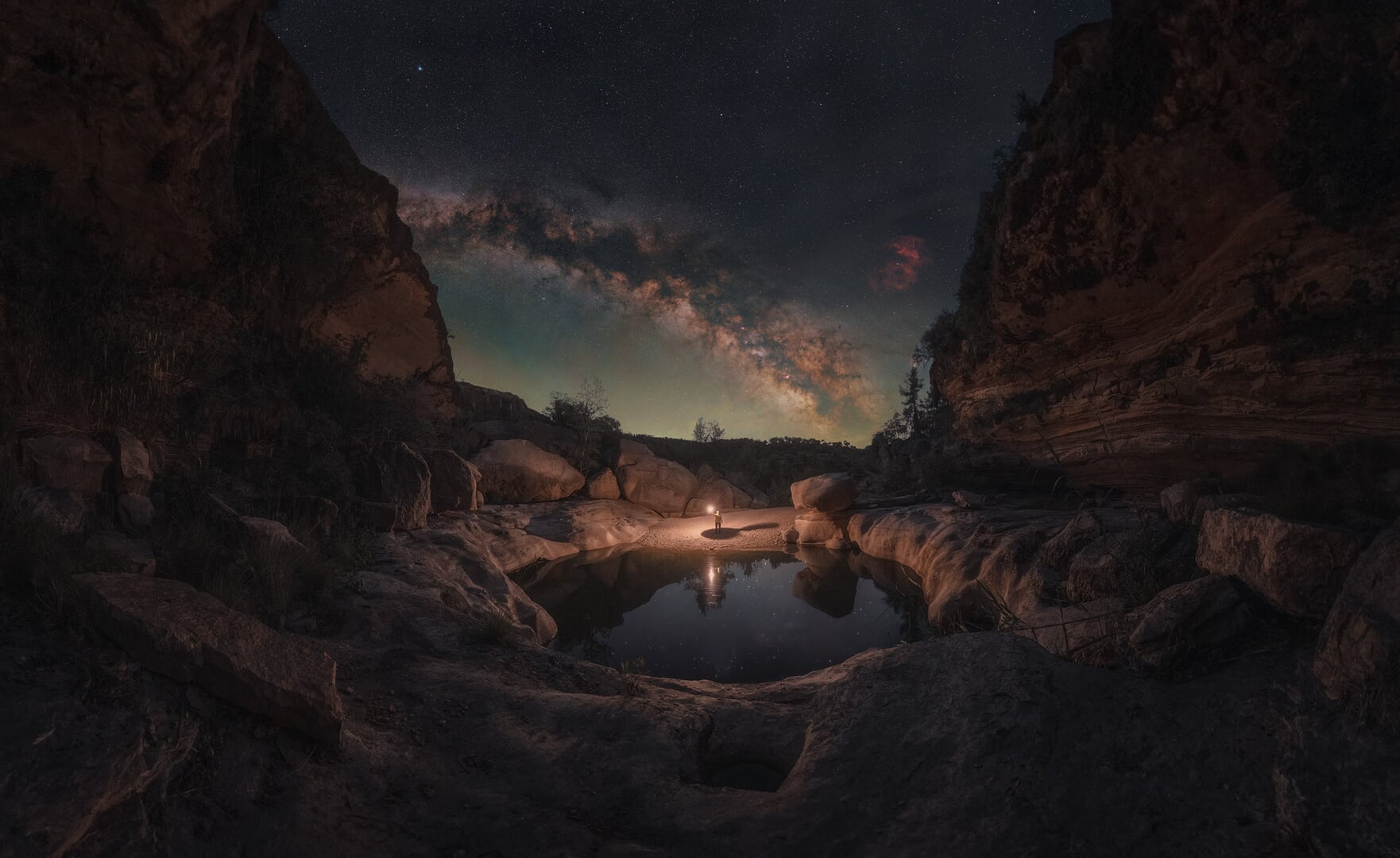
“Un Destello en la Oscuridad” – Luis Merino
- Comarca del Matarraña, Spain
In my quest to find new places to practice this beautiful hobby, I discovered this corner, which, with a touch of light, transformed into a dreamlike scene. The lighting highlighted every detail: a stream carved by water, which usually flows forcefully after heavy rains, was now a peaceful calm; and although the Milky Way didn’t fully unfold, the galactic center appeared framed like a radiant beacon in the vastness of the night sky. The gentle croak of the frogs provided the natural soundtrack to this experience, making each moment feel unique and filled with magic.
This experience taught me that light has the power to transform the ordinary into a scene of wonder, revealing nuances that would otherwise go unnoticed.
Sky: 1 row, 4 panel x 5 shots per panel, ISO 1600, f1.4, 25seg, 24mm
Foreground: 1 row, 3 panels ISO 6400, f2.8, 120 s, 8 mm
Software: APP, Pixinsight, Lightroom, Photoshop
“Stairway to Heaven” – Marcin Rosadziński
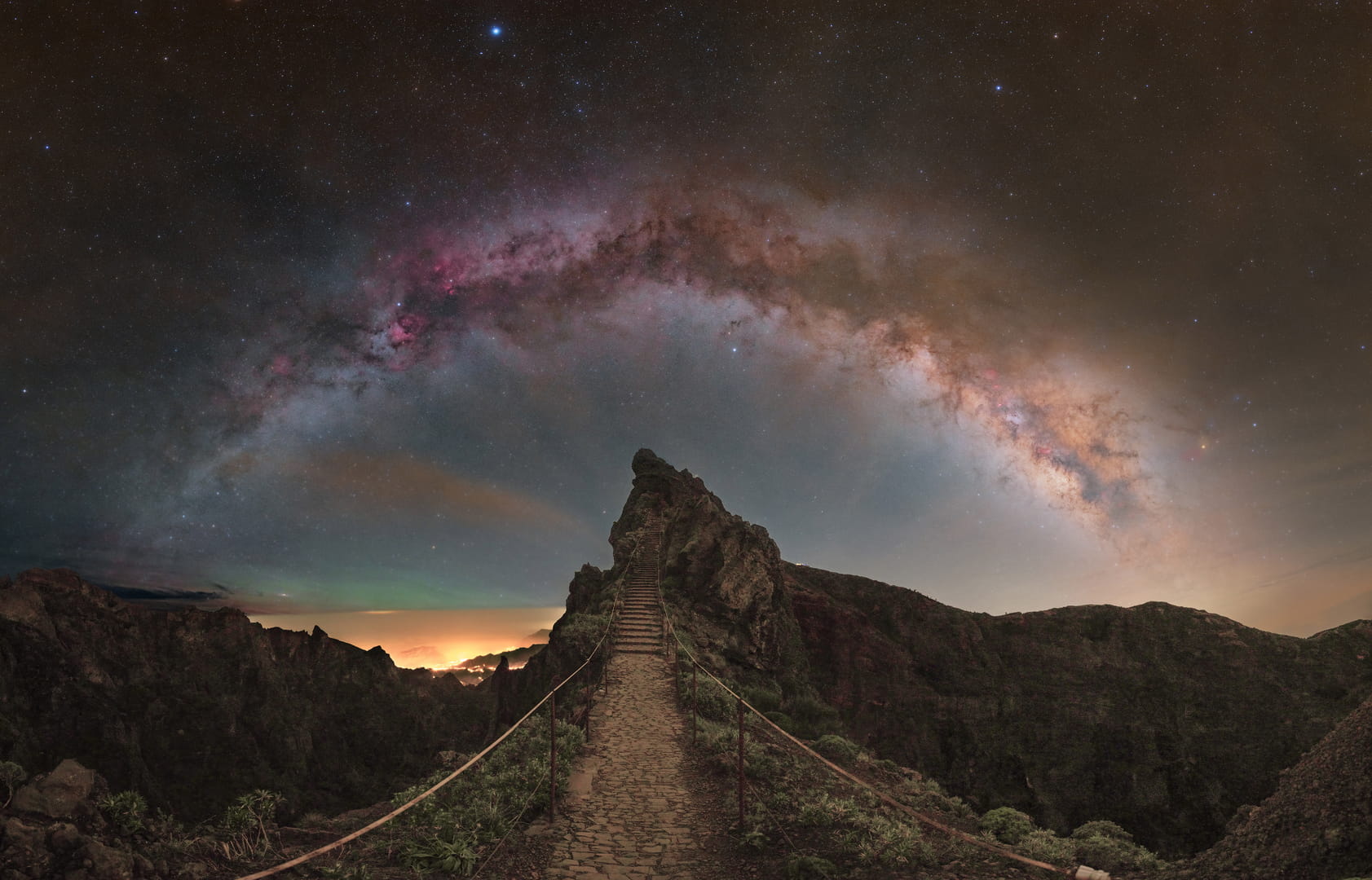
“Stairway to Heaven” – Marcin Rosadziński
- Madeira Island, Portugal
Taken in April 2024 on Madeira Island, this photo is a 14-panel mosaic (7 for the sky, 7 for the foreground). It shows the arc of the Milky Way over a rocky hill, giving the impression it’s suspended in the air. The wide angle reveals a vast stretch of the galaxy, with hydrogen nebulae glowing red. From right to left, you can see the constellations of Sagittarius, Ophiuchus, and Scorpius, along with the colorful Rho Ophiuchi and red-glowing Lagoon, Omega, and Eagle Nebulae. In the constellations of Cygnus and Cepheus, you can spot the North America and Elephant’s Trunk Nebulae.
The photo was taken at Pedra Rija, 1,800 meters above sea level, one of the island’s most beautiful viewpoints, accessed via the challenging PR1 mountain trail. Getting there with a 10kg backpack was tough, and after a sleepless night, the uphill return to the parking lot near Pico do Areerio was a real challenge. A sea of clouds illuminated by city lights adds extra beauty to the shot. On May 29th, 2024, it was featured as NASA’s Astronomy Picture of the Day.
Sky: 7 panels, each 2x25s, ISO1600, f2.8
Foreground: 7 panels, each 1x180s, ISO1600, f2.8
“Starlit Ocean: A Comet, the setting Venus, the Milky Way, and McWay Falls” – Xingyang Cai
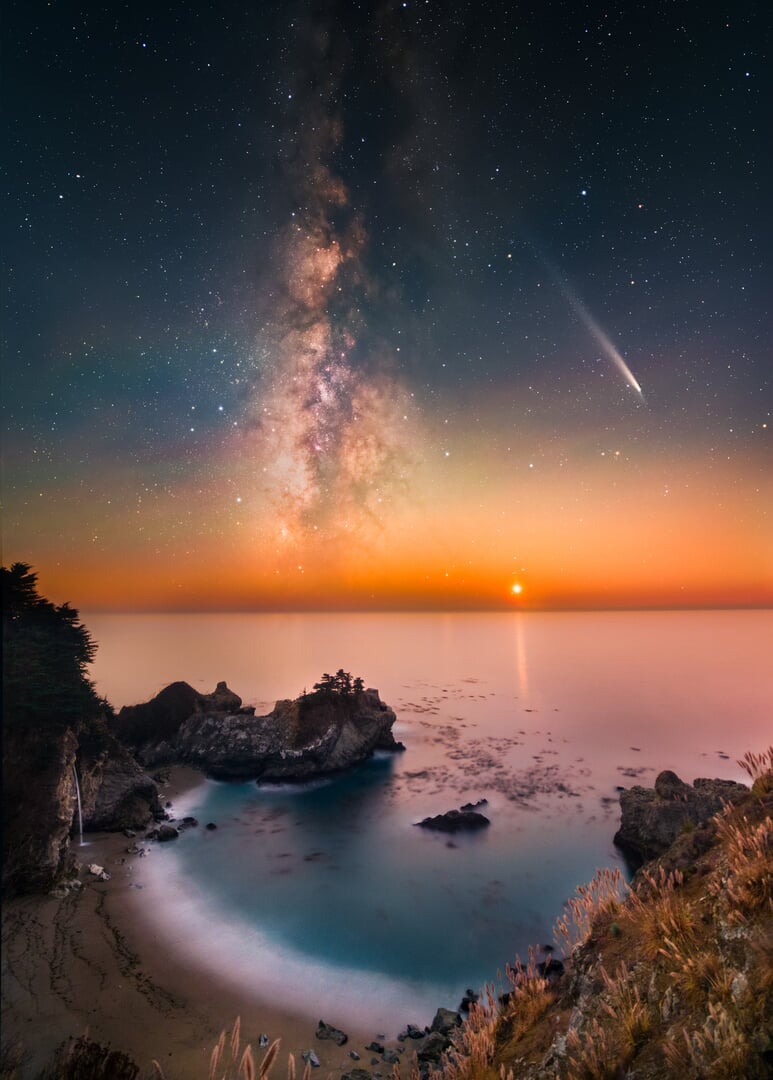
“Starlit Ocean: A Comet, the setting Venus, the Milky Way, and McWay Falls” – Xingyang Cai
- California, USA
Capturing this image was a race against time, light, and distance. With Comet Tsuchinshan–ATLAS (C/2023 A3) making its approach, I knew I had a rare opportunity to see it with the naked eye before it faded into the cosmos. I embarked on a five-hour round trip to McWay Falls in Big Sur, one of the few Bortle 2 locations accessible along California’s coast. My window was narrow—just six precious minutes of true darkness before the Moon rose and washed out the night sky. But those six minutes were unforgettable.
In that brief span, the Milky Way arched high above the Pacific, Venus shimmered as it set over the ocean, and the comet streaked quietly across the sky—a celestial visitor gracing this iconic coastal cove. The soft cascade of McWay Falls and the stillness of the starlit ocean created a surreal harmony between Earth and sky. It was one of the most vivid and humbling naked-eye comet sightings I’ve ever experienced—an alignment of cosmic elements that felt both fleeting and eternal.
Sky: Stack of 20 images, each at ISO 1600, f/1.4, 4-second exposure.
Foreground: Stack of 10 images, each at ISO 3200, f/1.4, 20-second exposure.
- Sony A7 III (astro-modified)
- Sony 14mm f/1.4
I hope you found these images inspiring and that they encourage you to go out and have incredible adventures photographing our galaxy.
If you’re interested in shooting the Milky Way, planning is key, and the best way to prepare your shootings is by downloading our free Milky Way Calendars, which help you figure out the best days and times to capture the galaxy according to your location.
GET THE CALENDAR WITH THE BEST DATES TO PHOTOGRAPH THE MILKY WAY IN 2025
You’ll also receive our PDF guide to photographing the Milky Way!

Many of the images on this year’s list were taken using some of the best star trackers. If you want to explore some advanced Milky Way photography, we recommend checking our star-tracker photography guide.
Also, don’t forget that camera gear for shooting the Milky Way and the best settings in Milky Way photography are important.
Thank you for sharing this article with others who might find it inspiring.
About Dan Zafra and the Curation Process Behind the Milky Way Photographer of the Year
Created by Dan Zafra in 2018, the Milky Way Photographer of the Year is an annual collection showcasing the 25 most exceptional Milky Way images captured worldwide over the past year. Each photograph is meticulously chosen from thousands of submissions based on the uniqueness of the location, the story behind the shot, technical excellence, strong composition, and authenticity—favoring images where the Milky Way and foreground were captured in the same place and time.
As a renowned astrophotographer who has captured night skies around the globe, leading astro workshops in diverse locations, and teaching advanced night photography techniques through Capture the Atlas, Dan Zafra brings deep expertise and a discerning eye to this selection.
Over the years, this project has grown into a leading reference for astrophotographers and major media outlets worldwide. Yet beyond celebrating extraordinary imagery, its mission remains steadfast since its inception: to inspire a deeper appreciation of our night skies and advocate for urgent efforts to preserve them for future generations.
Below is the gallery with all the images at their full size. Enjoy it!
Please do not download, copy or share any of the photos here without the author’s prior written permission. Consider the photos here to be protected by copyright. If anyone uses any of the photographs we will take the required legal actions.






